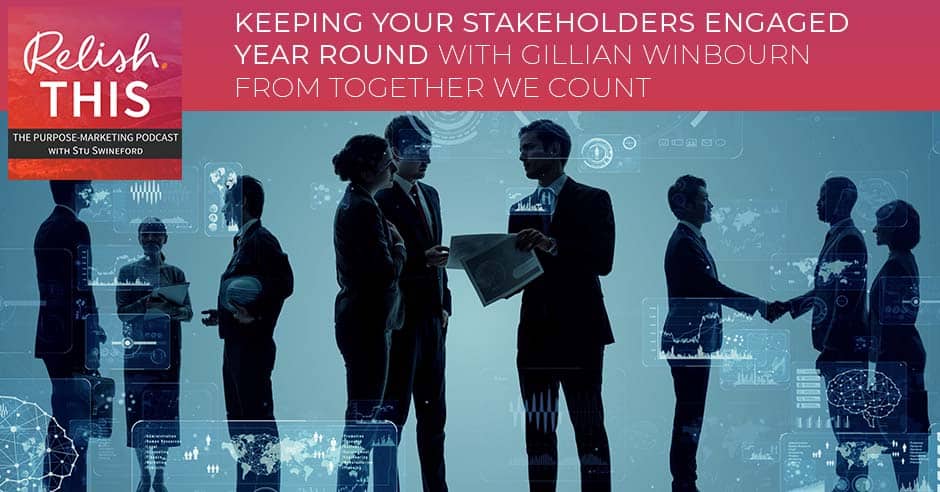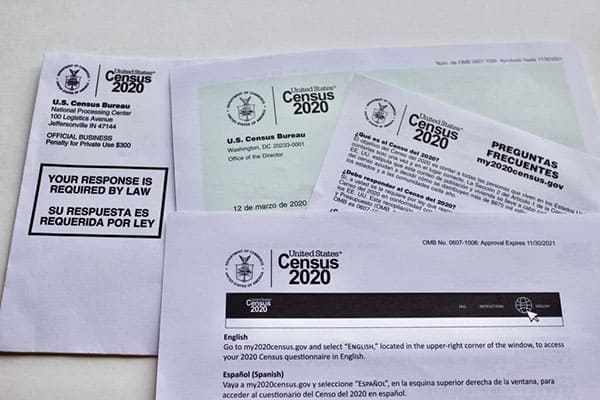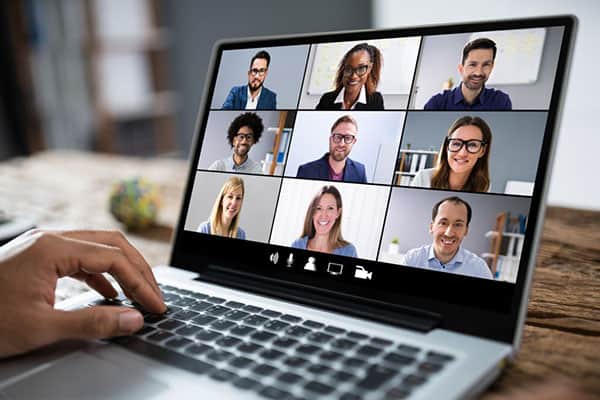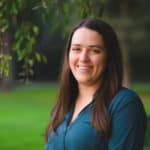
How can you keep your stakeholders engaged?
On today’s episode I speak with Gillian Winbourn, the Executive Director of Together We Count, a unique organization that creates and motivates coalitions to help with the Census every 10 years.
The cyclical nature of the Census means long periods of almost no interest from the public—punctuated relatively short bursts of interest and action. So Together We Count has some really interesting challenges around inspiring stakeholders and keeping them interested throughout the years.
These challenges present a really good opportunity to look at how organizations with similar, but far less extreme, periods of “downtime” can keep stakeholders engaged.
What’s your outreach plan? How can you keep your audience engaged when your organization may be taking a break?
There are some answers to be found in this episode. Hope you enjoy it.
Links
ASK
Pay attention during the redistricting process and get active to voice your opinion to your Representatives. Keep a look out for the American Community Survey and be sure to fill it out if you receive it.
—
Listen to the podcast here
Keeping Your Stakeholders Engaged Year Round With Gillian Winterbourn From Together We Count
My guest is Gillian Winbourn. She is the Executive Director of Together We Count, an interesting nonprofit that spins up activities once every ten years as we approach the census. They help create coalitions of people who are helping to make sure that as many people as possible are being counted for our census taking.
We talked a lot about the inspire phase of engagement, given that they have to try to figure out how to keep people engaged during this lull, and also have a real challenge with getting messages out and getting the word out about the census and how important it is. It was a fun conversation where she went into a ton of detail in terms of all the great work that they are doing over there. I hope you enjoy it. I had a great time talking with Gillian.
—
Gillian, how are you?
I am doing well. Thanks.
Thank you for being on the show. It is exciting to talk with you. We first met over LinkedIn. I talked with your former executive director over there at Together We Count. You are the new executive director, is that right?
Yes. I am the new executive director. It was because the 2020 census lasted longer than we anticipated. We were trying to brainstorm ideas on how to extend the program, the project and the organization. At the time that we were talking about extending and thinking about money ways, COVID was in full swing. We did not want to divert any money or resources away from a lot of the philanthropic efforts that were going into that emergency which is ongoing. One of the easiest ways for us is to move our executive director to a senior advisor role, and then I take over operations. She was still very much a part of the organization in a pretty hands-on way, but I just took over the backend aspect.
Doing a census is challenging in any year, much less one as hectic as 2020 was for all of us. Tell us a little bit more about your organization, what you guys are doing, and how things went.
It is funny that 2020 was so difficult because we assumed that the 2020 census would be difficult from many years out. In 2016 and early 2017, Rosemary Rodriguez has worked in the city council. She has worked for a past Denver mayor. She has worked for senators as a state director. She has been plugged into Colorado for many years, and she volunteered with the census since 1990.
She has a lot of personal experience with it. Early on, particularly with the rhetoric from the Trump administration, our general lack of trust in government, apathy about giving away information, and no one is door knocking anymore, she saw this problem coming from miles away and knew that there had to be more of an effort than ever before.
The census is a federal exercise. Together We Count is kind of the nonprofit hub organization for the state of Colorado.
We could not have anticipated COVID-19 at all but we did anticipate a lot of challenges. We were able to at least build a pretty good infrastructure to support the organizations that were doing work. That was critical to COVID-19 when everyone is in an emergency situation. There was no time or energy or capacity for people to take on the census as well as their other priorities if they did not already have it built into their organizations or if they were not also financially tied to doing census outreach. The census is a Federal exercise but has many partners statewide, regional and national, so we were the nonprofit hub organization for the State of Colorado.
Your organization gives grants and then helps other nonprofit organizations in the census years. Is that accurate?
Yeah. We had never existed in previous census cycles. The census bureau’s model for outreach is reliant upon organizations volunteering their time, energy and effort, which I think in the past has varying degrees of success. As the state and communities rely more and more on direct service providers and nonprofits, we knew that they would not have any capacity without any financial incentive to work on the census. We spent many moons and years talking with nonprofit organizations. They all said the same thing like, “We need money.”
We worked on raising funds for a mini-grant program to help organizations that were may or may not have been in the civic space. The census provided a lot of opportunities for organizations that wanted to stay non-partisan. The census affects everyone. We were able to bring in new partners to either the democracy or civic space that may not have been involved or were able to give money out to organizations that had done many campaign cycles and had done a lot of voter engagement and stuff like that. It was a pretty diverse coalition.
A lot of our work bled into other work that was being done nationwide and also helped us create a community so that when something like the grant program for census outreach from the State of Colorado was around, there were enough people that knew what needed to be done and what level of engagement this would take.
We are not a lobbying organization, but there were partners around that we are able to be informed and say, “This is going to take some serious money.” We think the state should be able to contribute to that significantly, which they were able to with the $6 million grant fund. We are building coalitions. The other funny thing about the census is that it is a Federal exercise. As many of us know, anything that deals with the Feds is much more complicated than you would imagine.
One of the main things we took on was training because I always say the census is deceptively complicated. You are dealing with people and with their houses. You’re dealing with people answering what they may feel as personal and identifiable information so it got complicated quickly. We wanted to make sure that we were a conduit of information because we know trusted community leaders and trusted nonprofits want to make sure that they stay trusted. They do not want to lie and give false information to the people in their community.

It sounds like it was a multi-pronged effort where there was an information distribution component where you are trying to just get out to the citizens and people who are being counted what to expect and allay some of those fears that may have existed, as well as try and mobilize a volunteer force.
The census cycle is challenging because it is every ten years. Even people at nonprofits that remember the last census, or if they do remember the last census, they do not remember the details of what was done or what worked best. Ten years is a long time ago, especially the 2010 to 2020 jump. We have extreme advances in social media and technology, so it is hard to plan for it. There are a lot of lessons to be taken from previous census cycles, but it does feel like you are almost reinventing the wheel each time. It takes a lot of training and support, more so than one might imagine.
It certainly sounds like a challenge. I can only imagine you get tossed into the deep end every ten years and figure it out. By the time the next census comes around, a lot of those people have that knowledge or have gone on to other things probably. You have to retrain people constantly.
People change jobs. That is a fact of life. Circumstances changed. I do not blame anyone. It is inherent in the ten-year cycle, but it does make it more challenging, especially when a lot of the work is assumed to be on a volunteer basis. You have people who even have the experience that may or may not have the capacity to take up the charge. That is a lot of loss of time and energy. You can’t always replicate that again.
How did it go in the state? Based upon coming into it with some trepidation, how did things turn out?
It is interesting that we know more now than we have in previous census cycles. The Census Bureau has been better about releasing information. Particularly with the digital census, they were able to give us in-time measurements of where certain areas were doing better than others. I will start geographically and then I will dive a little bit into the numbers and then the timeline is still messed up for the census and the impact.
Geographically, the other aspect is our most reliable data in preparation for 2020 was the 2010 census data. That is difficult in a place like Colorado, where we have had pretty expansive growth, especially in the Denver Metro Area but also in the Western Slope. We are already working from a deficit in the sense that we knew these communities have changed a lot. That is why it took so much engagement and talking to everyone we possibly could to make sure that we knew how the communities had changed, so we could use the qualitative and the quantitative aspects when we were looking at our maps and our numbers.
The census is very deceptively complicated because you’re dealing with people and their houses.
In terms of how COVID impacted the census, it was pretty brutal nationwide, but I would say that it hit us at a bad time in the mountain areas. The census online portal was opened on March 12th, 2020. We were at least able to be online, but particularly in these kinds of what the Census Bureau calls group quarters, a lot of in-person canvassing was supposed to commence around March 20th, 2020. That was all suspended.
If you lived in a rural area of Colorado that does not receive mail consistently or you have a PO box, you probably did not know that the census was happening maybe until June. We lost a lot of months in critical areas that we could not do anything about. There were definitely pockets of the front range area where we lagged behind, but the good thing is that we were able to see that early. We were able to at least do our best to course correct and try to help specific communities do targeted ads, targeted social media and stuff like that. Because of the COVID delays, the whole operation was delayed.
The online portal was up until October 15th, 2020, but we did have delays in the door-knocking operation, which is critical. Due to those delays, we won’t get the official census numbers until late 2021. This will impact redistricting and a whole host of other aspects that the Census Bureau has not exactly told us yet. The delays were critical. In Colorado, we potentially likely missed around 64,000 people, which is not insignificant. It is a large number. The question that we will always be looking for is, “Who do we think those populations were? Where were they located?” We can have a little bit of a sense of where they might be located based on the data that the Census Bureau released. That is where we are at right now.
In any census, you do miss some people. There are people that are over-counted and there are people that are under-counted. The two critical elements are the rural populations, which are a significant part of our state. We are delayed in receiving any census information. The second population are college kids. Typically, college kids are counted where they are living on April 1st. That can be their residential dorm or through living in a college town on off-campus housing.
When you had those kids sent home before April 1st, there was a lot of confusion on where they should be counted. It was confusing on the Census Bureau and our end. It was challenging to communicate that to our grantees, nonprofit partners and coalition because things were changing daily. We did not have a good sense of the timeline and the operation. It was pretty chaotic in terms of them combing through the data and making sure that it was accurate.
Are you still active right now or has the nonprofit spun down for the time being until we approach the next census? Do you run full-time throughout that ten-year cycle?
We are winding down. Ideally, all census work should work in between the ten-year cycle, but the reality of nonprofit work is that it is not necessarily realistic to continue to do census work for the next 4 or 5 years without anything concrete. Ideally, we will take this information and utilize it for other statewide issues such as vaccine hesitancy and any other civic engagement. We always said that we were going to be a temporary organization, which I am not sure if we should have said out loud too much, but we were lucky to be fiscally sponsored by Rose Community Foundation. They gave us a lot of space and time to build this.

They were supportive. It was an interesting organization because we never had an organization like this before, particularly for the census. It was a long-term campaign and a point in time. Those are valuable organizations, but they are challenging in terms of where they were housed, how do they look and how do they pivot. Part of the reason is Rosemary is semi-retiring, which she has done before. I will continue to work in this space, but it did not make sense. We are hoping and we have been able to talk to some statewide partners about making sure that this information lives on. Ideally, we would be able to what they call evergreen or at least that is what the census people say. We just could not figure out a way to make that happen.
Does the bulk of your revenue come from grants and partnerships? Where are you funded?
We are almost fully funded by Colorado philanthropic organizations. We did receive a pretty sizable grant from a national advocacy organization that was a group of national funders that pooled their money together to give out grants to people working on the state level, but we were mostly funded by Colorado foundations.
Does that fundraising typically happen during the five-year cycle that I heard you talk about a little bit, or do you start fundraising right away for 2030’s census for example?
There is what we did and what we think will be better in the future. A number of cities did create positions for census outreach coordinators. We think that more cities and counties should do that. We think that they should write it into their budgets starting in probably 2027 and ideally tie it a little bit more to economic development. That is one component that we did not quite make the connection early enough because the census is economic development.
It is paying for schools, jobs, roads and opportunity zones. Community block grants are all based on census. Ideally, that is one way. We do think that the state should continue to make this a legislative priority. They were able to allocate $6 million, which was not insignificant. We had a report done by the Colorado Fiscal Institute that called for $12 million for robust outreach. We know that it will continue to take that money, take that much. This is dependent upon the Federal level making census work still pretty voluntary on the state and the community level.
We do not anticipate that the Census Bureau will be able to have more resources for state and local, either nonprofits or governmental organizations. While we were happy that the philanthropic organizations took a gamble, they never had to invest in census work before. While we are happy, we also think that there should be continued funding streams from state and local agencies because it affects so much of our bottom line. It is what we have had for ten years. We were lucky and we were able to tap into great networks and had great support behind us. Ideally, we would like the support to be a little bit more institutionalized in the government. It won’t happen at the Federal level. I can see that on the horizon but at the state and local levels.
A census cycle is 10 years. There are a lot of lessons to learn from previous cycles, but you’re almost reinventing the wheel each time.
I like the idea of this economic play. I am on the Steering Committee of the Colorado Outdoor Business Alliance. One of the things that we have noticed is that framing the discussion in a way that is going to resonate with the person you are having that discussion with can be effective. We are all about environmental causes, land stewardship, lands conservation, and things of that nature. When framing arguments or discussions around those issues, depending upon the audience, we tend to recommend that people come at that discussion from a variety of different ways. When you are speaking perhaps with more green or progressive candidates, you can come at it from that environmental stewardship language and perspective.
When you are speaking with someone who is more fiscally conservative and business-oriented, it’s adjusting the way to have that conversation so that it comes from that perspective of small business growth or economic stability. It is interesting how you have to change that argument when you are making it based on who you are speaking with. I can see how coming at it from different perspectives when you are trying to get people on board with the funding could be an interesting challenge for you.
Honestly, my favorite thing about talking about the census was it was literally like take any topic and I will relate it back to the census. I had a couple of presentations. We live in Colorado. We have a lot of people that choose to live off the grid and do not want anything to do with the local state, especially the Federal government. I had a lot of those conversations. There was some pushback like, “This does not impact me. I do not care. I will just skip this one. I will sit it out.” They had come to whatever community event or senior event. I did a lot of senior events so I would say, “How did you get here today? What road did you drive in on?”
Looking at our transportation budget in the State of Colorado, most of our projects are now reliant on the Federal government. The fact that you were able to get groceries in your mountain community is because we have Federal highway dollars in Colorado to pay for the funding of those roads. We got a little lucky with the census, but I absolutely agree with your point that it is how you frame it. Particularly with funders, they have their own priorities. That is a great aspect and integral to their organization. With the census, this impacts so much and everything. It was easy to relate to it.
Bringing up the Colorado Outdoor Business Alliance, that was one area that we could not get our feet under. The census is non-partisan. In the past, in 2010, the National Census Bureau has had pretty good relationships with McDonald’s and Walmart and printing it on receipts. Even simple stuff like that, we did not have that in 2020. I will personally say that was pretty much due to the politicization of it by the Trump administration.
We had a number of businesses that felt too political. I hope it will change by 2030 because it was the most silly argument. I would be like, “It is in the constitution. How can it be political?” One thing we started at the end was talking about economic development. It is not my background and it is not necessarily Rosemary’s background. It did take us a little bit of time to understand that landscape and be like, “This is exactly economic development.”
I liked that you figured that out in terms of being able to start the conversations from that perspective. Perhaps in 2027 or whenever you start to ramp back up, having that as a framing opportunity is pretty valuable. It is interesting too that you mentioned the non-partisan component of it and how it did get politicized a bit in 2020 or this past cycle. That must be an interesting path to trot as well, where you have foundations and organizations that may have some political motivation or desire slant. How are you keeping those people engaged and excited about what you are doing, and maintaining that middle ground position that you need to maintain?

I would not say it was overall challenging, but it did have its challenges. It helped that the census has happened before, so it was not this completely new process. It started with the founding of our country. We made sure to highlight communities and the community impact. That was always our main focus. Also, it allowed us to make sure that the narrative stayed true to what we were doing. The Census Bureau has a definition of hard to count, which they look at as historically under-counted. A component that is it is the communities you might expect like immigrants and communities of color, but it also is rural.
All of rural America is hard to count for various reasons and renters. You have such a wide swath of people in that definition. We were able to utilize the Census Bureau even though some people at the top were working against that. We also use the Census Bureau’s own research and we would present that in meetings, especially to funders and to high-level people that were interested in what we were saying. The Census Bureau’s research, due to rhetoric, a lot of communities do not want to respond to the census. Making sure that we had not only anecdotal information from the state, but national research was pretty key to taking the stress off of the partisan aspect of the census.
We did not engage everyone. Another component is that some people did not view it as super important. I will say, in the end, it was interesting. We did get more people that were probably more involved and more passionate about redistricting when they heard the census might not be going as smoothly. Colorado is poised right now to gain another congressional seat. You had some people at the end calling that we’re concerned about that aspect of it. We want to make sure we get the congressional seat.
That is to be expected. In any coalition work, you have people that come in early and people that come in late. You try and stay on message. Having our program be statewide and focusing statewide allowed us to bring the conversation back to Coloradans because that is what this work was about. It was making sure that our state is counted because if it is not, we all suffer.
It is fascinating all the things you had to juggle there to get the job done. What portion of your outreach or your operating budget was around that outreach piece in terms of citizen education?
Our method was to train the trainer. We probably should have had a larger budget, I will say. We did not necessarily do the best job with social media. That was not something we prioritized that we probably should have. We focused on being the conduit between the messages we developed ourselves and from national advocacy organizations like NALEO Educational Fund and the National Leadership on Civil and Human Rights. They have staff, policy shops and communication shops. They were presenting us with national messages and then we would filter it through, take it and interpret it through the Colorado lens, and then pass it on to these organizations because, as a new organization, we had no community clout anywhere.
We did spend a significant amount of our budget, I would say probably about 30%, to make sure that these nonprofits were up-to-date with their communication. It ties back to that training. We developed a census guidebook. It was about ten pages. It was a glossy color. I tried to make it color-specific but after the training, they could take this. They could either use it with their promotoras or with our other staff, and have a resource right there where they did not have to call us every time they have a question. We had that in English and Spanish. Luckily, we had basic outreach cards that did not have a lot of dates on them. We could use them throughout the duration as the dates were changing.
The census is non-partisan but got more politicized by the Trump administration.
The other component is that we wanted to make sure that the information was as open-source as possible. Particularly with the coalition aspect, we did pay a cartographer to create a digital map of all of the grantees. Instead of the grantees having to go through us if they wanted to contact someone in their region or their area, they could just use this resource, go online, and see who else got funded and where they were working. The other thing that was interesting to us is a lot of these nonprofits are expanding into different areas either permanently or temporarily. Their offices might be in Denver but they work in Park County. They might have one staff member in the San Luis Valley but their main office is in Denver.
We created an open-source map with contact information and a little bit of detail. We do not want to be gatekeepers of this information. This is a coalition. This is important work. We want to make sure that everyone knows as much information as possible. That is why we provided our training for free. We gave out our materials for free. We tried to be a useful resource for these organizations. That would be in the wider comms budget, but it was a significant aspect of our budget.
One of the things I heard you mentioned was that you did not have a great or robust social media presence. All of these groups and organizations that came into that coalition, I am assuming they had mobilized quite a few volunteers or potentially had a wider reach opportunity that you could tap into.
Yeah, absolutely. Especially with COVID, most organizations pivoted to some type of online engagement, which became important. We were able to make sure that those organizations had the right messaging and the correct information available for their sites. We did do some Facebook ads, which was more challenging for census than typically because Facebook determine that census was a cause. You had to go through a little bit more hoops to make sure that you were able to verify your identity. The benefit was that we had little disinformation on Facebook, which was helpful as we have seen the opposite effect of that.
We did do some of that, but social media is definitely not my expertise at all so I can’t speak to it. We did do pretty well with our engagement online. It is hard to remember back but in 2020, we went through some rollercoasters of engaging online and then disengaging online and the yin and yang of it. It was hard to put a finger down on it. We did have some mini-grantees. They did phone banking and especially if their project was completely in person and they had to pivot, they did have a number of volunteers on deck. They are like, “How can we do this phone banking?” We helped develop a script and things like that. There were a lot of pivoting and movements at the end as well. It was not easy but I was impressed with how the organizations were able to handle it.
It sounds like you made the best of what you could do as everyone was trying to do in 2020. It is like, “What do we do now? Let’s give this a whirl.” I love the idea that you’ve mentioned a couple of times in terms of teaching the teachers, and empowering people to have the tools, the know-how, and the authority to be able to distribute that story. That falls in one of the phases of our engagement life cycle that we think about. It falls into this inspire phase where you’re trying to get all of your constituents or all of your stakeholders to further the cause in any way that they are able, whether that is making a donation, volunteering themselves, or sharing the word and spreading that message as far as you can.
Tapping into that wider network and giving them the tools to stay on the message would be something to keep in your back pocket when we roll into the 2030 census time. Who knows what will be going on then? At least that becomes an arrow in your quiver that you can deploy to help spread that message and make sure that it is accurate.

It was great for us. We had a half-day of training that we did make mandatory for the grantees, but we opened it up to anyone that wanted to join. Particularly when you have something like the census, that seems so boring to a lot of people. When you talk through it and get into the weeds of it, you are talking about how you identify racially and particularly the fear around the administration trying to add a citizenship question. You are getting into these pretty weedy aspects of how do we talk through this and how do I self-identify. I do not see myself on this form. Especially if you are from the Middle East or North Africa, technically, the advice is to designate yourself as White.
It was those tough conversations like, “I do not receive any benefit from labeling myself as White because I do not look White to other White people.” It was those conversations that made the census more personal. I do not think it fully did, but I think it helped them get over their reservations and helped us understand what those reservations were. I can be systems-oriented and forget about the people and then we would be in these training. They are like, “You are telling me the government is actually going to keep this information safe? When have they ever done that?” You are like, “Let’s talk through that. Let’s talk about how the Census Bureau is surprisingly different. I do not know why it is or I can tell you why it is.”
One of the biggest challenges, in the beginning, was talking with the Asian-American population because, in 2012, the Census Bureau admitted to the fact that they used census numbers for Japanese internment. Dealing with that cultural legacy in an age where a lot of people do not trust the government more, there were some recent cultural traumas and valid concerns that we needed to talk through. That training helped us bridge some trust with the people that we are going to be talking to. Having those conversations makes the engagement not as robotic or not as fake or what a lot of people would describe as inauthentic.
I was about to say it sounds more authentic which in theory, brings even more trust to the table. It is interesting that you mentioned authenticity because one of the things that I think harms both for-profit and nonprofit organizations out there is correspondence and automation, which all seemed good. We moved pretty far in that direction in a lot of respects, but we have gotten away from that authenticity where emails, messaging and advertising all feel like they are coming from machines as opposed to coming from a person to a person.
There seems to be a pretty decent movement or a desire to step back from that, and come back to the idea that we can create interactions and engagements that are helping to build relationships that are more authentic, and just taking the time to craft messaging, even if it is going out in bulk, and craft messaging that that does feel like it comes from a place of authenticity. It is interesting that you have seen that in your work as well.
I am relatively new to the space, but I had the pleasure of working with someone like Rosemary who has been doing a version of outreach almost her entire career, whether it was from an official place or an unofficial place. A lot of things have changed about it but a lot of core elements have not, which is talking to people or interacting with people one-on-one. People do not want to be lied to. They do not want to be misled. There are a lot of basic outreach and elements that we can tend to forget when we have new flashy technologies, which are great and totally beneficial.
We have to go back to the basics. That was one of the things we would talk to a lot of organizations about like, “Who’s your intake specialist? Could we train them?” They are the ones in your front office. A lot of organizations did hire a temporary census outreach coordinator because it is a full-time job. It takes a lot of work and takes that human interaction.
There are a lot of new flashy technologies today, which are great. But people shouldn’t forget about basic human interaction.
It is interesting to see how things are shifting back to this idea of authenticity and coming at it from a one-to-one instead of always thinking about, “How can I streamline this to get the message to the most people possible?” Do you have plans during this downtime to be somewhat active in terms of education in building trust in the census at all? Is it something that ramps up starting about 3 or 4 years out?
From my position, it would probably be ramping up. I do love the census. I would always talk about it to anyone, but the Census Bureau had positions called partnership specialists. They were community organizers. They were not called that but that is what they were doing. Unfortunately, they did not have a lot of resources to provide to organizations or local governments, but they were the organizing body on the ground. We had a great staff in Colorado and we worked well with them even if we did have critiques of the Census Bureau itself. There have been national calls to the Census Bureau to keep at least a number of those people on staff throughout the process to keep a little bit of the coalition alive, but also to do some education.
I know that they have done that in the past, but I am not quite sure what that will look like right now because I know a lot of the partnership specialists’ contracts end in October. There have been discussions. We are poised to at least retain more of that information from 2020 than we were in past census cycles, but there is not a ton of avenues right now. Particularly with COVID, we have some serious elements of daily life that we need to focus on. There has not quite been an appetite but hopefully, at least the Federal Census Bureau can maybe keep that charge up.
It is such an interesting topic. It comes around every ten years. We do not necessarily think about it a whole lot in between those times. What I am getting at is if there was a way to keep it not top of mind, but at least back there like, “That is this thing that we get to do every so often,” and continuing to get people to understand why it is in their best interest to engage with and be part of that process and make sure that everyone gets counted.
A conversation that has been happening with other advocacy organizations that I talk to nationwide is maybe not necessarily keeping the census drumbeat alive but keeping the coalition alive. As we have seen with COVID-19, there are instances where we need quick coalition-building rapidly. A number of organizations are working on redistricting, which is the most common next civic advocacy step for a lot of organizations.
We have two organizations, Common Cause and the Rural Communities Resource Center. They are leading the charge on the redistricting engagement outreach, but a number of nationwide organizations are pivoting to that. We are not, but there are a lot of ways that this type of network can continue, either through public health means, civic or anything like that. There are still talks about that. For the nonprofit cycle, longevity can feel challenging.
Especially on that ten-year cycle, maybe the play is to continue to come up with ways that these organizations and these groups that have come together to form this coalition can stay active in that down cycle between the years when they are super engaged and busy. Distribution of public health information is certainly an opportunity there. There may be some other things to keep all those people engaged during the downtime.

We will see.
This has been super fun. I am excited to know a bit more about how this part of our process works and to hear all the great things that you guys have done to help fuel it. How can people find out more about either the census or your organization, Together We Count?
The easiest way would be to go to TogetherWeCount.org. There, we did a story map or the timeline. There are a lot of visuals and maps of how the census went in 2020. Also, we wrote a policy guidebook for the 2030 census. That is utilizing the best practices that we did in the 2020 census and getting either local governments or nonprofits to start thinking about 2030.
We provide sample timelines, things we do not anticipate changing on the Federal level, things that worked, and things that did not work. All of those can be found on our website. You can contact me through that website as well. We will have those up. We are going to keep everything up through the redistricting cycle, but since we are not entirely sure when that will happen, we will continue to make sure that website stays up probably through the end of the year.
I would encourage everyone to go check that out. I would like to end all of my shows with an ask or an opportunity for you to give people something to do. I like the idea of having conversations that lead to action. If you were to ask people to take action after this interview, what would that action be?
It is funny. I feel like I have been asking people for so much for so long. There was a part of me that is like, “I have tapped myself out of that.” I would ask people to pay attention to redistricting. It can feel partisan, but there is a lot that can be done just as a community member. They take testimony on how the lines are drawn. There is a large process that might shift a little bit based on when the numbers come out. Pay attention to that and skip over the partisan elements of it.
The other aspect is in between the decennial census, the Census Bureau releases the American Community Survey. That is the only way that we can judge how accurate the 2020 census was and also provides us with more in-time information. It goes out to a very small percentage of the population, but if you do receive that, please fill it out. It does take a long time, but it is important to us. I would say those two things.

When does that usually come out?
It comes out every year. It only goes out to about 5% of the US population, but for some reason, in 2020, we kept getting so many calls. I feel like they were targeting Colorado. It does go out. It takes about 45 minutes to an hour to fill out. It is important information for us.
I may have gotten one of those earlier.
They were sending them out in 2022, which we begged them not to.
I got it in 2019. I filled it out. I remember it taking a while, but I am pretty sure I got one of those. That is pretty neat. Thank you so much for being on the show, Gillian. It was wonderful to hear what you have been up to. I am sure that you are ready for a little bit of a break. I am excited to keep in touch and hear how things start to ramp back up.
Thank you so much.
Guest Bio:

Gillian Winbourn is a policy advocate with experience in operations, program management, and grant-making. She achieves success by collaborating with others on a shared mission to create transformational solutions. Able to navigate political systems and build grassroots coalitions to achieve policy goals. Strong interest in leveraging background in advocacy and philanthropy in a social change environment.
